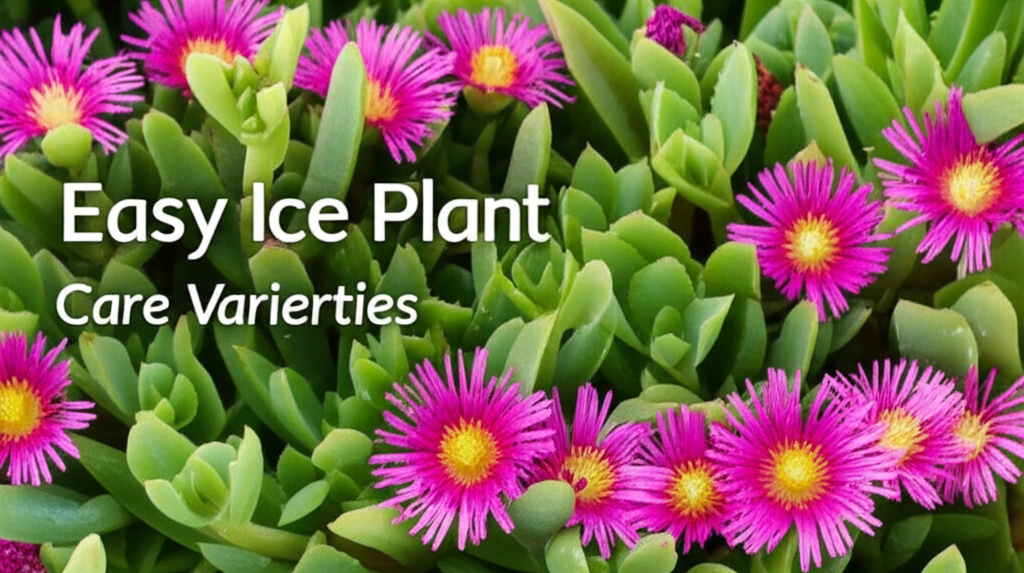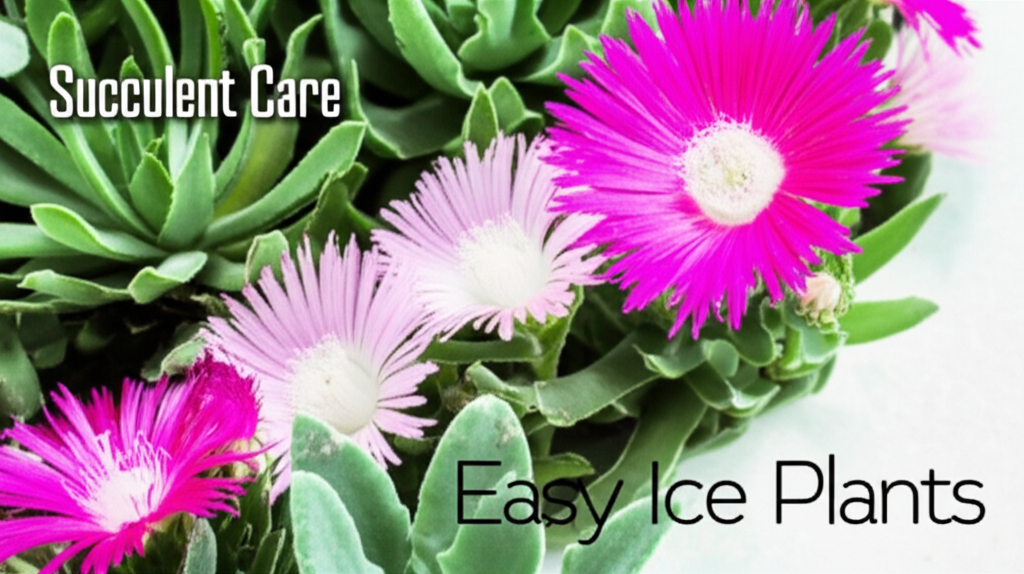Introduction to the Charismatic Ice Plant
Ice plants, belonging to the Aizoaceae family, are a diverse group of succulents renowned for their jewel-like appearance and remarkable resilience. Their common name stems from the tiny, translucent bladder-like cells that cover their leaves and stems, giving them a dewy, frosted look, especially in bright sunlight. These fascinating adaptations allow them to thrive in arid conditions, reflecting excess sunlight and storing precious moisture. For gardeners seeking low-maintenance yet visually striking additions to their landscapes or containers, ice plant succulents offer an abundance of beauty with minimal fuss.
This article delves into some of the most popular and easy-care ice plant succulent varieties, exploring their unique characteristics, ideal growing conditions, and how to propagate them. Whether you’re a seasoned succulent enthusiast or a beginner looking to add a touch of drought-tolerant charm to your garden, understanding the nuances of these sun-loving plants will ensure their successful cultivation and abundant blooms.
Why Choose Easy-Care Ice Plant Succulents?

The appeal of ice plants extends far beyond their aesthetic charm. Their ease of care makes them exceptionally well-suited for a wide range of gardeners and gardening situations.
Low Maintenance Needs
Perhaps the most significant advantage of these succulent varieties is their forgiving nature. They demand very little in terms of watering, fertilization, and pest control. Once established, they can withstand periods of neglect, making them ideal for busy individuals or those new to gardening.
Drought Tolerance
As native to semi-arid regions, ice plants are exceptionally drought-tolerant. Their specialized cells help them conserve water, allowing them to survive long periods without rainfall. This makes them a perfect choice for water-wise gardening and xeriscaping.
Vibrant Blooms
Despite their modest care requirements, many ice plant varieties produce an astonishing display of colorful, daisy-like flowers, often in shades of pink, red, orange, yellow, and white. These blooms typically appear in the warmer months, transforming dull patches into vibrant carpets of color.
Versatile Applications
The ground-covering habits of many ice plants make them excellent for:
- Rock gardens
- Slopes and embankments
- Container gardening
- Ground cover in dry, sunny areas
- Edging pathways and borders
Resilience to Harsh Conditions
Ice plants are generally hardy and can tolerate a wide range of environmental conditions, including poor soil and salty air, making them suitable for coastal gardens.
Key Easy-Care Ice Plant Varieties
While the ice plant family is vast, several species and cultivars stand out for their ease of cultivation and widespread availability.
Delosperma (Ice Plant)
This is perhaps the most widely recognized genus for “ice plants” in general cultivation. Many species within Delosperma are prized for their ground-covering abilities and prolific flowering.
Delosperma cooperi (Hardy Ice Plant)
- Description: This is one of the most popular and cold-hardy ice plants. It forms a dense mat of fleshy, green leaves and produces a profusion of vibrant magenta-pink flowers throughout the summer. It typically grows to about 4-6 inches tall and can spread up to 2 feet wide.
- Key Features: Exceptionally hardy (down to USDA Zone 5), drought-tolerant, long blooming period, spreads readily.
- Ideal For: Ground cover, rock gardens, borders, containers.
Delosperma lehmannianum (Tooth-leaved Ice Plant)
- Description: Distinctive for its triangular, toothed leaves, this ice plant forms a low-growing, sprawling succulent. It produces bright yellow flowers in summer. It is less cold-hardy than D. cooperi, typically thriving in USDA Zones 9-11.
- Key Features: Unique leaf structure, drought-tolerant, attractive yellow blooms.
- Ideal For: Dry, sunny locations, rock gardens, coastal gardens, containers.
‘Fire Spinner’ Ice Plant (Delosperma ‘Fire Spinner’)
- Description: A popular cultivar of Delosperma, ‘Fire Spinner’ is celebrated for its multi-colored flowers that transition from yellow at the center to orange and then to a deep red at the petal tips. It forms a dense, low-growing mat.
- Key Features: Striking bi-colored blooms, drought-tolerant, good for ground cover.
- Ideal For: Adding a pop of color to rockeries and borders.
‘Jewel of Desert’ Series (Delosperma ‘Jewel of Desert’ Series)
- Description: This series offers a range of spectacular colors, including amethyst, ruby, sapphire, and topaz. These are compact, low-growing ice plants known for their prolific flowering and exceptional vigor. They are generally hardy to Zone 5.
- Key Features: Wide range of vibrant flower colors, compact growth habit, prolific bloomer.
- Ideal For: Containers, rock gardens, small spaces, borders.
Lampranthus (Trailing Ice Plant)
Lampranthus species are also commonly referred to as ice plants, often distinguished by their more trailing or cascading growth habit and often more numerous, smaller flowers. They are generally less cold-hardy than many Delosperma.
Lampranthus spectabilis
- Description: This species is known for its abundant, daisy-like flowers in shades of vibrant pink, purple, and red, appearing in late winter and spring. It has a semi-trailing habit, making it excellent for hanging baskets or spilling over the edges of pots and walls. It prefers USDA Zones 9-11.
- Key Features: Early and prolific bloomer, cascading habit, drought-tolerant.
- Ideal For: Hanging baskets, container edges, walls, rockeries.
Lampranthus aureus
- Description: Characterized by its bright yellow to orange flowers, Lampranthus aureus offers a sunny display in spring and early summer. It forms a dense, spreading mat of cylindrical, grey-green leaves. This species is also suitable for USDA Zones 9-11.
- Key Features: Cheerful yellow-orange blooms, drought-tolerant, good for mass planting.
- Ideal For: Ground cover, mass plantings, rock gardens.
Malephora (Trailing Ice Plant)
This genus also features ground-covering succulents with ice-plant characteristics.
Malephora crocea
- Description: This species typically has a sprawling habit and produces striking orange-red flowers that can open in the morning and close in the afternoon. Its succulent leaves are somewhat flattened and often have a bluish-green hue. Hardy to USDA Zones 9-11.
- Key Features: Bright orange-red flowers, drought-tolerant, attractive foliage.
- Ideal For: Xeriscaping, rock gardens, hot, dry locations.
Key Facts and Comparison of Popular Ice Plant Varieties
To help illustrate the differences and similarities between some of the most popular easy-care ice plant succulents, the following table provides a quick reference.
| Variety | Genus | Hardiness Zone (Approx.) | Typical Flower Color | Growth Habit | Leaf Appearance |
|---|---|---|---|---|---|
| Hardy Ice Plant | Delosperma | 5-9 | Magenta-pink | Low, spreading mat | Fleshy, green |
| Tooth-leaved Ice Plant | Delosperma | 9-11 | Yellow | Sprawling | Triangular, toothed |
| ‘Fire Spinner’ | Delosperma | 5-9 | Yellow-to-red | Low, spreading mat | Fleshy, green |
| ‘Jewel of Desert’ Series | Delosperma | 5-9 | Various (pink, purple, red, yellow) | Compact, low-growing | Fleshy, green |
| Lampranthus spectabilis | Lampranthus | 9-11 | Pink, purple, red | Semi-trailing, cascading | Fleshy, cylindrical, grey-green |
| Lampranthus aureus | Lampranthus | 9-11 | Yellow-orange | Dense, spreading mat | Fleshy, cylindrical, grey-green |
| Malephora crocea | Malephora | 9-11 | Orange-red | Sprawling | Flattened, bluish-green |
Cultivating Your Ice Plant Succulents: A Step-by-Step Guide
Growing ice plants is a rewarding experience due to their resilience. Here’s a breakdown of the essential steps and factors to consider.
1. Choosing the Right Location
- Sunlight: Ice plants absolutely thrive in full sun. Aim for at least 6-8 hours of direct sunlight per day. Insufficient light can lead to leggy growth and reduced flowering.
- Soil: Excellent drainage is paramount. They prefer well-draining, gritty soil. A sandy loam or a cactus/succulent potting mix is ideal. Avoid heavy clay soils that retain too much moisture.
2. Planting and Potting
- In the Ground: Amend the planting area with compost and grit to improve drainage. Dig a hole twice the width of the plant’s root ball. Gently remove the plant from its nursery container, loosen any tightly bound roots, and place it in the hole so the top of the root ball is level with the soil surface. Backfill with soil and water thoroughly.
- In Containers: Use pots with drainage holes. A terracotta pot is excellent as it allows soil to breathe and dry out more quickly. Fill with a well-draining succulent mix. Plant as you would in the ground.
3. Watering
- Established Plants: Once established, ice plants are incredibly drought-tolerant. Water deeply but infrequently. Allow the soil to dry out completely between waterings. Overwatering is the most common cause of root rot.
- New Plants/Containers: Newly planted succulents will require more frequent watering to help them establish their root systems. Check the soil moisture regularly.
- Winter Watering: Reduce watering significantly during the dormant winter months, especially in cooler climates.
4. Fertilizing
Ice plants are not heavy feeders. A light feeding in the spring with a balanced, water-soluble fertilizer diluted to half strength is usually sufficient. Over-fertilizing can lead to weak, leggy growth and fewer flowers.
5. Pruning and Maintenance
- Deadheading: Remove spent flowers to encourage more blooms and keep the plant looking tidy.
- Trimming: If the plant becomes leggy or overgrown, it can be trimmed back. Pruning can be done in spring or early summer. Cuttings can often be used for propagation.
6. Propagation
Ice plants are remarkably easy to propagate, making it simple to expand your collection or share with friends.
- Cuttings: Stem cuttings are the most common method. Take 4-6 inch cuttings from healthy stems. Remove the lower leaves and allow the cuttings to callus over for a day or two before planting them in a well-draining potting mix. Keep the soil slightly moist until roots form.
- Seed: While less common for home gardeners, ice plants can also be grown from seed. Sow seeds in a well-draining seed-starting mix in spring.
Pros and Cons of Growing Ice Plant Succulents
Like any plant, ice plants have their advantages and disadvantages.
| Pros | Cons |
|---|---|
| Exceptional drought tolerance | Susceptible to root rot in poorly drained soil |
| Low maintenance requirements | Most varieties are not frost-tolerant (except hardy Delosperma) |
| Prolific and colorful blooms | Can spread aggressively, potentially outcompeting other plants if not managed |
| Excellent for xeriscaping and water-wise gardens | May require protection in very cold climates |
| Easy to propagate | Can attract aphids in some instances, though generally pest-resistant |
| Visually striking foliage and flowers | |
| Tolerant of poor soil conditions |
Troubleshooting Common Issues
While generally hardy, a few common issues can arise if care requirements aren’t met.
1. Mushy or Yellowing Leaves
- Cause: Overwatering or poor drainage.
- Solution: Reduce watering frequency and ensure the soil dries out completely between waterings. If planted in the ground, amend the soil with grit or compost to improve drainage. For potted plants, repot into a better-draining mix and a pot with adequate drainage holes.
2. Leggy Growth (Stretched Stems)
- Cause: Insufficient sunlight.
- Solution: Move the plant to a sunnier location. Prune back the leggy stems to encourage bushier growth.
3. Lack of Flowers
- Cause: Insufficient sunlight, overwatering, or excessive nitrogen fertilization.
- Solution: Ensure the plant is receiving at least 6-8 hours of direct sunlight daily. Reduce watering and avoid fertilizing with high-nitrogen formulas.
4. Pests
- Cause: While usually resistant, ice plants can occasionally attract aphids or mealybugs.
- Solution: A strong spray of water can dislodge many pests. For more persistent infestations, use insecticidal soap or neem oil, following product instructions carefully.
Conclusion
Ice plant succulents offer a unique blend of visual appeal, resilience, and ease of care, making them a fantastic choice for gardeners of all skill levels. From the hardy, vibrant blooms of Delosperma cooperi to the cascading beauty of Lampranthus spectabilis, there’s an ice plant variety to suit almost any sunny, well-drained spot. By understanding their simple needs for sun, well-draining soil, and infrequent watering, you can enjoy these captivating, drought-tolerant gems for years to come, transforming your garden into a vibrant, low-maintenance oasis. Embrace the sunshine, embrace the sparkle, and let these easy-care ice plants bring a touch of frosted magic to your landscape.


